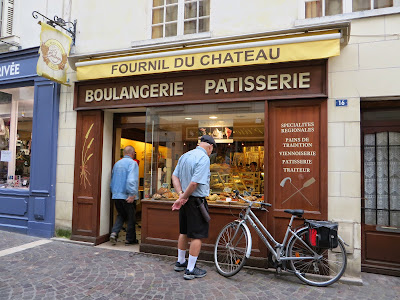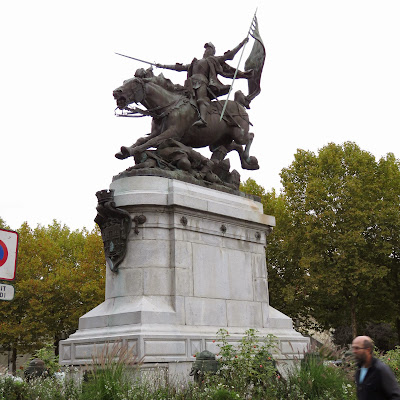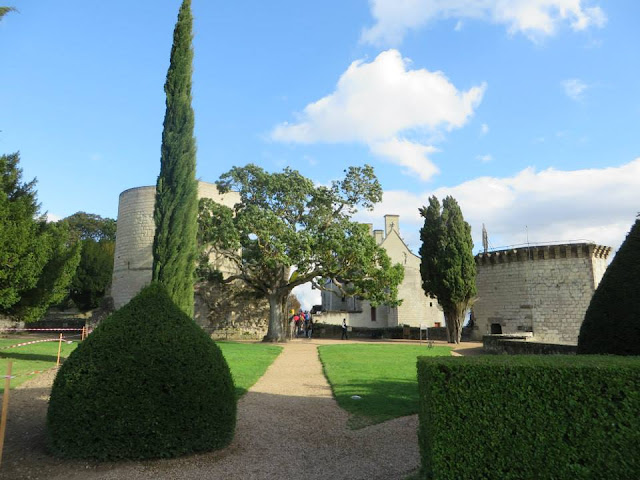Memorable, creakless oak stairway at the Hotel de France
Breakfast was good, but I had trouble boiling my egg in the machine long enough.We ate in the same room behind the lobby where dinner was served the night before. Miriam asked me to accompany her on a walking tour of the town after breakfast, and I agreed. Up to the room briefly for cameras, and I was back in the lobby and ready to head out.
We crossed the little, tree-filled square in front of the hotel, went left past the Chinon city hall, and walked west a few blocks to the Vienne River. It is a tributary of the Loire, and it was quite wide with water up and flowing nicely. This rapid flow and impressive width were greater than that of rivers in Texas. The French would consider our rivers creeks.
The Vienne River
Miriam Stauff
Morning sunshine in Chinon
Chinon was divided by the river into the old town on the east side below the Chateau and "newer" housing on the west side of the stream. Traffic on the bridge was intermittent, so Miriam and I took turns taking each other's photographs out on the span.
I kept thinking how similar this looked to the setting of The Lion in Winter; Chinon is the place where the story really took place. I could easily picture Eleanor's barge coming up the river from the Loire--all the way from prison in Salisbury Castle in England--turning and heading to shore to meet King Henry II (Peter O'Toole). Henry asked Eleanor (Katherine Hepburn) if the Channel parted for her. As she stepped ashore, she answered, "It went flat when I told it to; I didn't think to ask for more."
From that castle high on the hill to the east, above the town, Henry ruled "the largest empire since Charlemagne"--half of France and all of England, Ireland, part of Scotland, and Wales. We would be going up there after lunch.
We left the bridge and paused by a large statue of Rabelais. Chinon was his birthplace, and here he wrote Gargantua and Pantagruel, excepts of which I read in French class at UT-Austin.
It's not every year I visit the birthplace of RABELAIS!
We then walked back town and looked for a local "cave." We had learned that caves, pronounced with a very soft French A, as in kahve, were once actual caves or spaces dug into the side of hills that had come to be used as wine cellars. Here in Chinon, hub of an important wine-producing area, there were several at the base of the high hill below the castle. We did find one, now a wine shop, that was open, and we ambled around through town and admired the aged, limestone beauty of the place. I was amazed by the arching patterns of cobblestones in the streets. These people didn't just put granite down to form streets; they did it with artistic design and flair. It's in their DNA. Everything, but everything, had to look good.
Arching cobblestones
Chinon is where Joan of Arc first met the Dauphin.
Next, we walked down a narrow street and saw the place where the house had stood that Rabelais grew up in. Then I shot a few more pictures as we headed to a park on the south end of Chinon near the river.
Site of the house where Rabelais was born and reared
We turned a corner, headed back up this street, and suddenly the scene was so beautiful, I just had to shoot another picture! This isn't a famous building; it's just one of many wonderful scenes in Chinon, France.
lovely square with an awesome equestrian statue of Joan. Here we ran into Jack Thomas from Palo Alto. I also marveled at the enormous French sycamore trees which lined the river at that end of town. The French and British call them "plane trees."
Statue of St. Joan in park by the river
House where Joan of Arc stayed when she came to meet the Dauphin
By the wall of the inn is a well where Joan got off her horse and drew water on March 6, 1429.
Gordon in front of a "plane tree"
We walked back to the Hotel de France to freshen up before lunch. I changed into slacks and a windbreaker because I wanted to be warmer for the castle height. Louis met us in the lobby, took us on his own brief walking tour of the south end of Chinon and back to the Ardoise Restaurant. We ate on the first floor at long, narrow tables set aside for our group. The main dish was braised beef and potatoes, which along with wonderful wine and great bread, went down well.
L'Ardoise
There were some interesting chalkboards on the wall, one of which had a memorable slogan which translated roughly, "Know that if you chose cremation instead of being buried, you would always avoid the risk of having a small worm in your nose!!!"
Colorful motto at the Ardois Restaurant
Wonderful pear dessert (poached pear in ice cream with red currants and sprig of mint) at L'Ardoise in Chinon--fabulous "sights" such as this greeted us throughout Survey of France!
After lunch, Louis led us quickly back through the square, past the hotel, through a large parking lot, to a very large, public elevator at the base of the mountain overlooking the town. I
was astonished that we simply boarded the elevator, punched buttons, and went up. No attendant
was there to take money or assist us. It was simply a public elevator up to chateau level, and our admission and docent had already been arranged for a certain time. As we ascended, the view out the back glass wall of the elevator was stunning. We could see both ends of Chinon and for miles down the river, where boats made their way from a long distance. The flags hanging over the entrance of the first building marked the entrance to the Hotel de France.
Looking up the hill at gate tower of the Chateau
Elevator up to the level of Chinon Castle--Richard Dillon and Len Andrew approach the elevator as Louis Bideau rounds up strays. C'est moi.
Views from the castle height were spectacular!
The elevated path wound through a tall castle gate that Rapunzel would have been at home in. We then gathered in an open area near the castle entrance and met our docent before she led us inside. Distant walls and towers encircled a large, open courtyard.
We toured the interior of Henry Plantagenet's headquarters where he and Eleanor of Aquitaine reared their children--where Richard the Lionhearted and John Lackland grew up. I was somewhat surprised by the small size of the bedrooms, but that made sense because of the difficulty of heating spaces with fireplaces inside such a massive stone structure.
The history of this marvelous defensive chateau comes way past the Plantagenets. During the Hundred Years War and long after the French had acquired this area, Dauphin Charles took refuge from the English here. Here is where he was partying when young Joan of Arc picked him out.
Gordon Smith enters Henry Plantagenet's Headquarters.
Home of Henry II and Eleanor of Aquitaine
Local guide lectures on Chateau Chinon
Model of Chateau Chinon
Sturdy construction!
After leaving the main castle building, we went throughout the towers that surrounded the courtyard. These offered many great views of the town of Chinon and the Vienne River below. More boats were coming up the river. What a perfect medieval fortress this was--with its height and views and steep inaccessibility!
Something that struck me is that there were slight differences, yet great similarities, with the views shown in The Lion in Winter. I could easily picture Peter O'Toole gazing down behind the courtyard to see a farmer plowing a field below--or of the hectic scene when he roused everyone in the middle of the night to take Alice to Rome with him. I could not forget that early morning shot of Henry II's breaking ice in his wash basin; plate glass had not been invented, and the windows were covered only by iron bars.
In the film, the river went straight down to the shore--with no space included for a town. The location of the shooting was similar, but not exactly the same.
In later years, this had been a prison, and one of the towers was where Jacques DeMolay had been held. A wall even contained some graffiti he had etched in the stone.
Walking the castle grounds
Paul and Johanna Schuller
This tower was used as a prison. The Knights Templar were held here, the most famous of whom was Jacques DeMolay. What follows are cells that held them and some graffiti they etched on the
walls.

"Graffiti" etched by Jacques de Molay
The couple on the bridge are Paul and Johanna Schuller. After one last trip across the yard to the distant, primitive "toilettes," I climbed up on a high rock to see the downhill view from the back of the fortress and had a very pleasant surprise. Below me to the east vineyards covered the land, and I could see grape harvest going on right below me!This was a dream come true! Here were men loading trailers with grapes. Then they were pulled away by trucks and tractors. A large sign read Domaine Couly-Dutheil. We would pass by the estate tomorrow on our way to Tours, and their wine would be at our tasting after dinner at the hotel tomorrow night.
I called to the Len and Helen Andrew to come up for the view. We were all on our own by now and could leave whenever we chose. By this time, it was almost dark, and I was one of few people left up there. The view was delightful as I gazed at the town below and saw lights starting to come on. Soon I went back down that huge elevator to town level and walked the short distance back to the hotel. Tomorrow, we would go to Tours, Amboise, and Chenonceaux. What an adventure!
Looking behind the Chateau, I spotted the Couly-Dutheil vineyards which spread all over the hills. Harvesting of grapes was going on as I took these pictures. It's something I'd always wanted to see!
Fin




























































